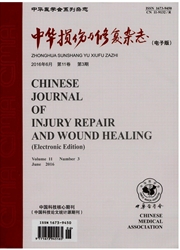

 中文摘要:
中文摘要:
目的用选择性激光烧结(SLS)技术构建纳米羟基磷灰石(Nano-HA)/聚己内酯(PCL)人工骨支架,观察其微观结构,与转基因种子细胞相复合构建出组织工程化Nano-HA/PCL人工骨支架,观察其修复兔桡骨大段骨缺损的效果。方法配置Nano-HA质量分数为15%的Nano-HA/PCL混合材料粉末,采用SLS技术制备出纯PCL与Nano-HA/PCL人工骨支架并用电子显微镜(SEM)观察Nano-HA/PCL人工骨支架的微观结构。64只新西兰兔制作骨缺损动物模型后随机分为4组,每组16只。以携带h BMP-7目的基因的兔骨髓间充质干细胞(MSC)作为本研究的种子细胞。复合材料组骨缺损处植入Nano-HA/PCL人工骨支架+种子细胞,单纯材料组骨缺损处植入Nano-HA/PCL人工骨支架,对照组骨缺损处植入纯PCL人工骨支架,空白组骨缺损处不植入任何材料。对4组进行术后大体观察,分别于术后第2、4、8、12周各组中随机选取4只兔,经Micro-CT扫描,Micro-view软件进行骨缺损植入区域的三维重建,观察骨缺损修复情况。将各组第12周骨缺损样本石蜡切片用苏木精-伊红染色与Masson染色后,普通倒置显微镜下观察。结果电子显微镜下观察Nano-HA/PCL人工骨支架的骨架具有相互连通的孔隙结构,同时在PCL颗粒表面均匀黏附着NanoHA颗粒粉末。复合材料组术和单纯材料组术后第7天、对照组术后第14天均能用前肢站立;术后第28天,复合材料组右前肢主动活动范围基本正常,单纯材料组右前肢可自主活动但活动受限,对照组右前肢自主活动明显受限,空白组仍不能用前肢站立。术后1~14 d,各组缺损区域均无感染现象,缺损伤口均为甲级愈合。使用Micro-view软件对4组Micro-CT扫描结果进行三维重建,术后第12周时观察到空白组骨缺损两端仍没有完全连接。对照组骨断端已完全连接,但骨髓腔未通,单纯材料组骨缺损区域新骨结构完整、连续,缺损几乎完全修复,骨髓?
 英文摘要:
英文摘要:
Objective Fabricate of Nano-hydroxyapatite ( Nano-HA)/poly-e-caprolactone (PCL) scaffolds with the selective laser sintering (SLS) technique to investigate its morphology. Then combined with rabbit marrow mesenchymal stem cells loaded with hBMP-7 gene to test its ability of repairing long bone segmental defects. Methods Mix Nano-HA and PCL powders at different weight ratios (with Nano-HA weight accounting for 15% ). Fabricate Nano- HA/ PCL scaffolds with the SLS technique. A total of 64 healthy adult New Zealand White rabbits were studied. The middle of the radius was chosen as the site of bone long defect. Using the rabbit marrow mesenchymal stem cells loaded with hBMP-7 gene as seed cells. The middle of the radius was chosen as the site of bone segmental defect. All rabbits were divided into four groups : A ( Nano-HA/PCL artificial scaffold + seed cells), B ( Nano-HA / PCL artificial scaffold), C ( pure PCL scaffold ) and D ( The blank control group ). Both Nano-HA/PCL scaffolds and PCL scaffolds were implanted in rabbit radius defects. Postoperative general behavior of the rabbits were observed. The implanted areas were scanned in a micro-CT system at different time (2, 4, 8, and 12 weeks). The formation of new bone tissue inside the macropores of the scaffolds in all groups was studied by histology. Results The SEM images of the surface morphology and microstructure of the fabricated porous scaffolds showed well-ordered and interconnected macropores. The rabbits of group A and B had no abnormal gait on postoperative day 7, but the group A were more active. On postoperative day 7, the group C could stand up by their forelimb,while the rabbits from group D failed to stand. The wound showed no obvious infection. The micro-CT images showed that the group A made the most extensive bone ingrowth throughout the entire volume of the implants at postoperative week 12. While there were only a small amount of new bone tissue in the defects for group B. The group C were associated
 同期刊论文项目
同期刊论文项目
 同项目期刊论文
同项目期刊论文
 期刊信息
期刊信息
